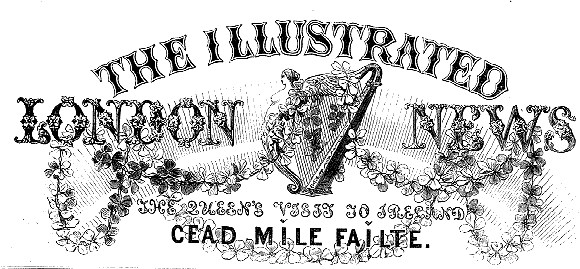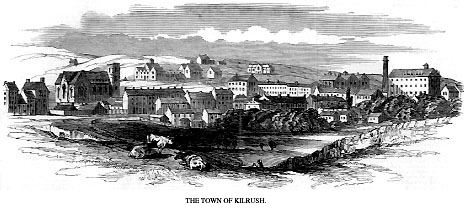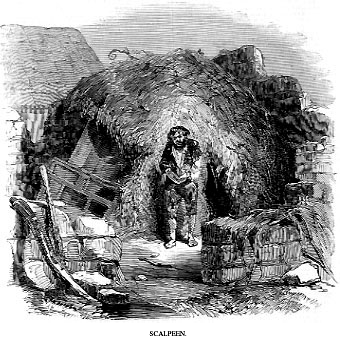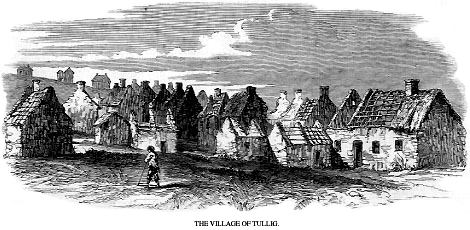
|
THE ILLUSTRATED LONDON NEWS. |
[Dec. 15, 1849. |
![]()
CONDITION OF IRELAND:
ILLUSTRATIONS OF THE NEW POOR-LAW
(From our own Correspondent.)
[The present fearful Condition of Ireland, made considerably worse, we believe, by the operation of the New Poor-Law, has induced us to give, as far as possible, a faithful report of the working of this law with Illustrations of Localities, sketched by our own Artist.]

GENERAL STATE OF KILRUSH
Kilrush, which gives its name to a Poor-law Union, will be celebrated in the history of pauperism. With Clifden, Westport, Skibbereen, and other places, it forms one of the battle-fields of Ireland, in which property, under the guidance of legislation, has fought with poverty, and been worsted in the conflict. It is our purpose to describe the progress of the contest, and, as Sterne took a single victim to make mankind sensible of the horrors of slavery-- as a single case of flogging women did more to rouse the people of England against the iniquities they had countenanced in the West Indies, than many volumes of general description-- we presume that we shall make the condition of Ireland, and the working of the Poor-law there, more effectually known by selecting a single Union for remark, than by parading before our readers a great multitude of statistical facts. Our Commissioner is on the spot, and we illustrate the Sketches and condense the facts he has supplied us with. Sketch No. 1. represents the town of Kilrush.
As an appropriate introduction, we quote from the Times of Tuesday an account of the
"DEPLORABLE STATE OF THE KILRUSH UNION.
"The Limerick papers bring melancholy accounts of a "crisis" which has at length taken place in the affairs of this unfortunate Union. Money and credit are all gone, and starvation has literally set in among the paupers in the workhouse, the inmates having been sent to bed on Thursday night without having eaten any dinner-- the only remedy that the guardians could suggest to numb the sense of hunger. The Limerick Chronicle's statement is as follows:--
"'Notwithstanding the exertions of the local board and Poor-law inspectors, the in-door paupers were obliged to go to bed without dinner on Thursday night. The master brought the state of the house, as regards want of provisions for that day, before the board, when soup and chopped turnips grown on the land was the only food available. The out-door paupers are in a desperate state, crowding the dépôts and following the relieving officers by thousands to town to get into the workhouse; but one day's admission (300 admitted) so crowded the auxiliary, that admission was impossible. Barley, the produce of the land about the workhouse, has been ordered to be threshed; but are 2600 paupers to be fed on the principle of "live, horse, and you'll get grass?" It is fearful to think of the state of Kilrush Union-- nothing but starving creatures fro the country to be seen pouring into a starving workhouse; the Board meet every day, but, if we are to judge from the general confession of that body, they are able to effect no good. The chairman, Colonel C. M. Vandeleur, took the chair yesterday, and his presence was sufficient it was thought to get the 'needful,' but to no purpose; out-door paupers and relieving officers were sent home, and in-door paupers recommended to go to bed. The coroner attended an inquest on a man who was found in a dying state o the side of the road near Kilmury. Mortality in the workhouse has been small; but, owing to the able-bodied on the out-door relief being struck off, the deaths in that department are every day increasing to a frightful extent. Relieving officers complain that they must bury their dead without coffins. The Board yesterday agreed to petition the Poor-law Commissioners on the state of the Union, and said that the guardians would not be morally responsible for the deaths that may occur through starvation.'"
Kilrush is in the county of Clare, and on one bank of the Shannon. It is situated in a district that is both fertile and picturesque. It has all the conveniences of a haven, and might have all the advantages of a great trading and fishing port. It is, for Ireland, a tolerably large town, with well-built stone houses, and broad, clean streets, though it has plenty of mud cabins and dirt, like every other Irish town. It is going rapidly to decay, and most of the houses could be bought for less than the value of the stones they were built with. The Poor-house is now, and likely to be for a long period, the principal building in the town, and, with the Catholic chapel, constitute its architectural distinctions.
The Union to which it gives a name consists of nine districts:-- 1. Kilrush and Killimer. 2. Knock and Killofin. 3. Kilfiddan and Kildysert. 4. Kilmihil and Kilmacdooan. 5. Kilmury. 6. Killard. 7. Kilkee. 8. Moyarta. 9. Kilballyowen. It extends right across the Clare peninsula, between the Shannon and the Western Ocean, and contained, in 1841, a population of 82,358. Of this population, very considerably reduced in numbers, there were no less than 22,661 receiving relief out of the workhouse, at the cost per week of £559, in April, 1849; and in June the number was increased to 29,049, who were maintained at a cost of £780 16s. 5d. Taking the average of the two months, the number relieved was more than 35 per cent.; the cost of maintaining them was something less than 6d. per head per week. At the same period there were i the union workhouse about 2500 paupers, making the total number of persons relieved in June 31,549, or more than 43 per cent. of the population of 1841. If we knew the exact number at present, greatly reduced as it its, we should, no doubt, find that considerably more than one-half of the whole population, or more than 50 per cent., are receiving relief. So far as mere figures go, it is an afflicting picture to see every man, woman, or child, in possession of a crust or a pound of meat, besieged by another beggar for a share of that which is hardly sufficient for his own wants.
 From this general view we pass to an example of the manner in which the out-door paupers live. In the workhouse the people, till the last arrival, were tolerably well taken care of; and such is the general destitution, that they were well housed, clothed, and fed, in comparison with the mass. Our second Sketch represents what is called a Scalpeen. There is also something called a scalp, or hole dug in the earth, some two or three feet deep. In such a place was the abode of Brian Connor. He has three in family, and had lived in this hole several months before it was discovered. It was roofed over with sticks and pieces of turf, laid in the shape of an inverted saucer. It resembles, though not quite so large, one of the ant-hills of the African forests. Many of the people whose houses have been levelled take up their abodes in such places; and even in them there is a distinction of wretchedness. A Scalpeen is a hole, too, but the roof above it is rather loftier and grander in its dimensions. It is often erected within the walls when any are left standing, of the unroofed houses, and all that is above the surface is built out of the old materials. It possesses, too, some pieces of furniture, and the Scalpeen is altogether superior to the Scalp. In such, or still more wretched abodes, burrowing as they can, the remnant of the population is hastening to an end, and after a few years will be as scarce nearly as the exterminated Indians, except the specimens that are carefully preserved in the workhouse. Those whom starvation spares, disease cuts off.
From this general view we pass to an example of the manner in which the out-door paupers live. In the workhouse the people, till the last arrival, were tolerably well taken care of; and such is the general destitution, that they were well housed, clothed, and fed, in comparison with the mass. Our second Sketch represents what is called a Scalpeen. There is also something called a scalp, or hole dug in the earth, some two or three feet deep. In such a place was the abode of Brian Connor. He has three in family, and had lived in this hole several months before it was discovered. It was roofed over with sticks and pieces of turf, laid in the shape of an inverted saucer. It resembles, though not quite so large, one of the ant-hills of the African forests. Many of the people whose houses have been levelled take up their abodes in such places; and even in them there is a distinction of wretchedness. A Scalpeen is a hole, too, but the roof above it is rather loftier and grander in its dimensions. It is often erected within the walls when any are left standing, of the unroofed houses, and all that is above the surface is built out of the old materials. It possesses, too, some pieces of furniture, and the Scalpeen is altogether superior to the Scalp. In such, or still more wretched abodes, burrowing as they can, the remnant of the population is hastening to an end, and after a few years will be as scarce nearly as the exterminated Indians, except the specimens that are carefully preserved in the workhouse. Those whom starvation spares, disease cuts off.
Even from the Scalps the poor are hunted. "None of the houseless class," says Captain Kennedy, the poor-law inspector, "can now find admittance into some over-crowded cabin, whose inmates seldom survive a month." A month's agonies-- the result of hunger, dirt, and fever-- after being expelled from a home, suffices to destroy life. It is a sort of Majendie experiment made on human beings-- not on cats in an air-pump, or on rabbits with prussic acid. Yet the instinctive love of life is so great, so strong is the sentiment by which Nature ensures the continuance of the race, that Brian Connor dreads nothing so much as that he shall not be allowed, now that his hut has been discovered, to burrow longer in security; and like a fox, or some other vermin, he expects to be unearthed, and left even without the shelter of what may be called a preparatory grave. The mud cabins and turf huts that the peasantry lived in before 1846 were denounced by every traveller as the scandal of civilised Europe; and it was supposed that worse habitations were not on the earth; but the Irish have proved that in their lowest deep there is still a lower deep-- that a Scalpeen is worse than a mud-hut, and a Scalp worse than a Scalpeen.
Men who are wretched and men who are criminal keep each other in countenance, and perpetuate crime and wretchedness. What hope, then, can be entertained or ever again elevating the Irish, when the bulk of them are degraded to Scalps and starvations, even to the dignity of mud cabins and plenty of potatoes? They may die out or may be killed off; but, when the half of the whole live on 6d. per week, and are thankful for being allowed to burrow in Scalps, there must be more hope of the savages of New South Wales or the Brazils, than of those whom knaves have flattered with the name of the "finest peasantry in the world."
A great and just sympathy is just now excited by the sufferings of the needlewomen of the metropolis, and by the hard labour and poor pay of females in various branches of town industry. But they at least find shelter; most of them have clothing; they manage to get food, though the supply is scanty; and the most crowded lodging-house of the metropolis is a palace compared with the Scalp, or burrowing hole, of the Irish peasant.
The present condition of the Irish, we have no hesitation in saying, has been mainly brought on by ignorant and vicious legislation. The destruction of the potato for one season, though a great calamity, would not have doomed them, fed as they were by the taxes of the state and the charity of the world, to immediate decay; but a false theory, assuming the name of political economy, with which it has no more to do than with the slaughter of the Hungarians by General Haynau, led the landlords and the legislature to believe that it was a favourable opportunity for changing the occupation of the land and the cultivation of the soil from potatoes to corn. When more food, more cultivation, more employment, were the requisites for maintaining the Irish in existence, the Legislature and the landlords wet about introducing a species of cultivation that could only be successful by requiring fewer hands, and turning potato gardens, that nourished the maximum of human beings, into pasture grounds for bullocks, that nourished only the minimum. The Poor-law, said to be for the relief of the people and the means of their salvation, was the instrument of their destruction. In their terrible distress, from that temporary calamity with which they were visited, they were to have no relief unless they gave up their holdings. That law, too, laid down a form for evicting the people, and thus gave the sanction and encouragement of legislation to exterminate them. Calmly and quietly, but very ignorantly-- though we cheerfully exonerate the parties from any malevolence; they only committed a great mistake, a terrible blunder, which in legislation is worse than a crime-- but calmly and quietly from Westminster itself, which is the centre of civilization, did the decree go forth which has made the temporary but terrible visitation of a potato rot the means of exterminating, through the slow process of disease and houseless starvation, nearly the half of the Irish.
The land is still there, in all its natural beauty and fertility. The sparkling Shannon, teeming with fish, still flows by their doors, and might bear to them, as the Hudson and Thames bear to the people of New York and of London, fleets of ships laden with wealth. The low grounds or Corcasses of Clare are celebrated for their productiveness. The country abounds in limestone: coal, iron, and lead have been found. It has an area of 827,994 acres, 372,237 of which are uncultivated, or occupied by woods or water. It is estimated that there are 296,000 acres of unoccupied land; and that of these 160,000 are capable of cultivation and improvement. Why are they not cultivated and improved, as the wilds of America are cultivated and improved by the brethren of the Irish? Why are these starving people not allowed and encouraged to plant their potato-gardens on the wastes? Why are they not married to the unoccupied soil, as a humane politician proposes to provide for the starving needlewomen of the metropolis by marrying them to the Currency Lads of New South Wales? A more important question cannot be asked. There is about Kilrush, and in Clare, and throughout Ireland, the doubly melancholy spectacle of a strong man asking for work as the means of getting food; and of the fertile earth wooing his labours, in order to yield up to him its rich but latent stores: yet it lies idle and unfruitful. Why is not this doubly melancholy spectacle destroyed by their union, and converted into life and happiness, as oxygen and hydrogen, each in itself destructive, become, when united as water, the pabulum of existence? We shall fully consider that question before we quit the subject, but we shall now only say that the whole of this land, cultivated and uncultivated, is owned by a few proprietors-- that many of them are absentees-- that almost all are in embarrassed circumstances-- and that, from ignorance, or false theory, or indolence, they prefer seeing the land covered with such misery as we have described, to either bringing the land under cultivation themselves, or allowing the people to cultivate it. Their greatest ambition, apparently, is to get rid of the people.

Our third Sketch shows the desolation to be seen about Kilrush and in many other parts of Ireland. No conqueror ever left more conspicuous marks of his devastation. The Sketch is not of a deserted village-- though that was a miserable enough spectacle, for the wretched beings who once viewed it as the abode of plenty and peace still linger and hover about it-- but of a destroyed village. The ruthless spoiler has been at work and swept away the shelter that honest industry had prepared for suffering and toiling humanity. A conqueror would not have had time and security to do the mischief which is perpetrated in safety under the guardianship of the laws by the Irish themselves. Within the Union of
Kilrush, in the year of grace 1849, and before the coming of the month of June, about 16,000 persons had been unhoused out of 82,358, and 1200 were unhoused within one fortnight of May 7, in all, one-fifth or 20 per cent. of the whole population were turned out of their houses and the houses pulled down. Not less than 2890 houses were levelled in the Union of Kilrush in the years 1848-49. Ireland is now marked with many such monuments of the terrible mistakes of landlords and of the legislature as the roofless village represented in our Sketch.
![]()